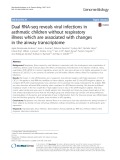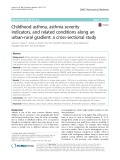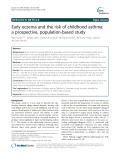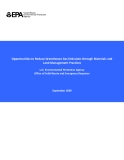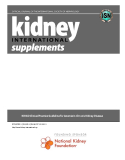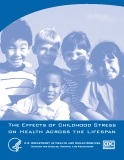
Developing childhood asthma
-
Respiratory illness caused by viral infection is associated with the development and exacerbation of childhood asthma. Little is known about the effects of respiratory viral infections in the absence of illness. Using quantitative PCR (qPCR) for common respiratory viruses and for two genes known to be highly upregulated in viral infections (CCL8/CXCL11), we screened 92 asthmatic and 69 healthy children without illness for respiratory virus infections.
 17p
17p  vialfrednobel
vialfrednobel
 29-01-2022
29-01-2022
 7
7
 0
0
 Download
Download
-
As part of an investigation into the respiratory health in children conducted in Torino, northwestern Italy, our aim was to assess development in lung function from childhood to adolescence, and to assess changes or persistence of asthma symptoms on the change of lung function parameters.
 8p
8p  vimontana2711
vimontana2711
 05-04-2021
05-04-2021
 13
13
 1
1
 Download
Download
-
Asthma prevalence is generally lower in rural locations with some indication of an urban-rural gradient. However, among children with asthma, certain rural exposures thought to protect against the development of asthma could aggravate the condition.
 9p
9p  vimaine2711
vimaine2711
 26-03-2021
26-03-2021
 9
9
 1
1
 Download
Download
-
Severe eczema in young children is associated with an increased risk of developing asthma and rhino-conjunctivitis. In the general population, however, most cases of eczema are mild to moderate.
 8p
8p  vivalanbo2711
vivalanbo2711
 19-03-2020
19-03-2020
 10
10
 1
1
 Download
Download
-
Allergic diseases, such as asthma, dermatitis, rhinitis, and eczema, are highly prevalent in Chinese school children. Environmental factors, including air pollution and automobile exhaust, play an important role in the etiology of these diseases.
 10p
10p  vivalletta2711
vivalletta2711
 11-01-2020
11-01-2020
 24
24
 0
0
 Download
Download
-
The prevalence of pediatric allergic diseases has increased rapidly in the United States over the past few decades. Recent studies suggest an association between the increase in allergic disease and early disturbances to the gut microbiome.
 8p
8p  virome2711
virome2711
 13-01-2020
13-01-2020
 9
9
 1
1
 Download
Download
-
Exposure to tobacco smoke both prenatally and after birth is associated with measurable harmful effects including a greater risk of developing asthma-like symptoms in early childhood. However, evidence of increased risk of allergic diseases is uncertain77, 78. Distinguishing the independent contributions of prenatal and postnatal maternal smoking is problematic79. However, studies of lung function immediately after birth have shown that maternal smoking during pregnancy has an influence on lung development37.
 98p
98p  dacotaikhoan
dacotaikhoan
 26-04-2013
26-04-2013
 29
29
 2
2
 Download
Download
-
Infections. During infancy, a number of viruses have been associated with the inception of the asthmatic phenotype. Respiratory syncytial virus (RSV) and parainfluenza virus produce a pattern of symptoms including bronchiolitis that parallel many features of childhood asthma53,54. A number of long-term prospective studies of children admitted to the hospital with documented RSV have shown that approximately 40% will continue to wheeze or have asthma into later childhood53.
 17p
17p  dacotaikhoan
dacotaikhoan
 26-04-2013
26-04-2013
 47
47
 2
2
 Download
Download
-
Much of what is known about asthma risk factors comes from studies of young children. Risk factors for the development of asthma in adults, particularly de novo in adults who did not have asthma in childhood, are less well defined. The lack of a clear definition for asthma presents a significant problem in studying the role of different risk factors in the development of this complex disease, because the characteristics that define asthma (e.g.
 39p
39p  dacotaikhoan
dacotaikhoan
 26-04-2013
26-04-2013
 45
45
 2
2
 Download
Download
-
This paper focuses on developing an empirical strategy for measuring the effect of pollution on health. Specifically, I look at the effect of air pollution on children's hospitalization for asthma. Childhood asthma is of particular interest for two reasons: 1) asthma is the leading chronic condition affecting children; and 2) current pollution standards are based on adult health responses to pollution and children face a greater risk from pollution exposure due to the sensitivity of their developing biological systems. This study builds on earlier work in five ways.
 64p
64p  can_thai
can_thai
 12-12-2012
12-12-2012
 120
120
 8
8
 Download
Download
-
Mortality rates among children and the absolute number of children dying annually in developing countries have declined considerably over the past few decades. However, the gains made have not been distributed evenly: childhood mortality remains higher among poorer people and the gap between rich and poor has grown. Several poor countries, and some poorer regions within countries, have experienced a levelling off of or even an increase in childhood mortality over the past few years.
 16p
16p  connhobinh
connhobinh
 10-12-2012
10-12-2012
 52
52
 2
2
 Download
Download
-
Through MICYRN, a pan-Canadian collaboration linking databases for 13 existing pregnancy/birth cohort studies has been established. Three additional birth cohort studies - the Canadian Healthy Infant Longitudinal Development (CHILD) asthma and allergy birth cohort, the Integrated Research Network in Perinatology of Quebec and Eastern Ontario and the Interdisciplinary Team in Childhood Obesity - have recently been funded as the first components of the MICYRN birth cohort coalition.
 0p
0p  connhobinh
connhobinh
 10-12-2012
10-12-2012
 50
50
 0
0
 Download
Download
-
Asthma is now the most common chronic childhood disease, occurring in approximately 54 of every 1000 children (21). From 1980 through 1996, childhood asthma increased dramatically, by approximately 5% per year (14, 16, 26). The etiology of asthma is complex and multifactorial; risk factors include genetic predisposition as well as exposure to environmental and infectious triggers.
 26p
26p  connhobinh
connhobinh
 10-12-2012
10-12-2012
 61
61
 1
1
 Download
Download
-
Given the relationship between exposure and disease, removing these pests and their allergens is a logical tactic for preventing disease and reducing symptoms, but current methods need improved efficacy. Results from studies on avoiding allergens suggest cau- tious expectations about the ease with which long-term clinically relevant allergen reduc- tion can be accomplished. Also, public health practitioners should be aware that focusing on one aspect of asthma control will not necessarily result in an improvement in the pre- valence of asthma at the community level.
 18p
18p  quygia123
quygia123
 02-11-2012
02-11-2012
 48
48
 3
3
 Download
Download
CHỦ ĐỀ BẠN MUỐN TÌM








